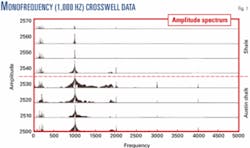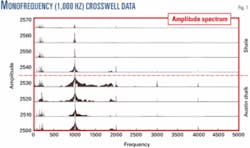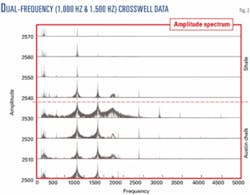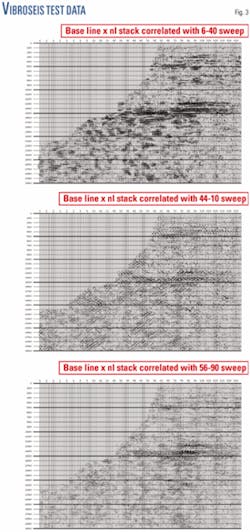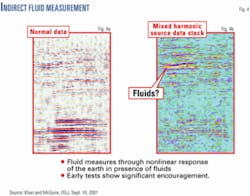SPECIAL REPORT: Nonlinear seismic data can improve hydrocarbon recovery from reservoirs
Integration of conventional seismic data with nonlinear seismic data can provide the industry with new opportunities to better map in situ reservoir properties.
This approach will directly affect the bottom line of any exploration company that wants to differentiate itself from its competition.
Defensive culture
The world’s expanding demand for oil and natural gas poses an unprecedented challenge for the industry to develop new technical innovations that will improve the productivity from the existing reservoirs and assist in discovering new reserves that have gone undetected by the current seismic imaging methods.
The introduction of the needed innovations may be hampered by a tendency in the geophysical industry to believe passionately in the practices it has carried out for a number of years. This tendency promotes a culture that makes great efforts to defend the older assumptions made somewhere earlier in the development cycle of the technology.
Quite often, this type of defensive culture tends to promote mediocrity and a tradition-bound activity in the particular scientific field. New theoretical alternatives are strongly resisted and numerous articulations and modifications of the original practices are introduced, trying to eliminate the weaknesses facing the current system.
It is time to accept that the current seismic imaging technology has reached its essence and its future development has reached a plateau. Indications that such may be true are confirmed by the fact that by using current technologies, 60-70% of the oil in many existing reservoirs is being left unproduced because the reservoir architecture and its pore fluids cannot be mapped with certainty.
To overcome the current shortcomings of the seismic imaging methods and to avoid an approaching crisis, what is needed is to move away from the old paradigms and develop new concepts that will provide solutions to some of the existing seismic imaging puzzles.
The current practices provide ambiguous results that create room for error and subjective interpretation. A perceptual transformation is necessary to improve the reliability of the current seismic methods currently used to identify and map reservoir rocks and their pore fluids and distinguish them from nonreservoir formations.
During the earlier development cycle of the seismic reflection work, it was assumed that all the subsurface rocks could be treated as an elastically linear medium. This assumption served the industry well for mapping subsurface structural information. However, extraction of the reservoir properties based on this school of thought has become increasingly difficult.
Results based on the linear measurements of velocity, attenuation, and modulus provide reservoir models that are not unique. The seismic attributes used today cannot easily distinguish between the responses created by the reservoir fluids or changes in subsurface lithology. The heterogeneities of the earth magnify these uncertainties.
The reservoir rocks of greater interest to the oil industry are the rocks that have porosity, permeability, and are saturated with hydrocarbons. A subsurface imaging method that will highlight these basic physical reservoir properties will help in producing more reserves from the existing fields and finding the subtle oil and gas traps left behind due to the shortcomings of the existing seismic imaging methods.
Elastic nonlinear seismic
The reservoir rocks of interest are complex and heterogeneous and contain a variety of mesoscopic structural features (cracks, voids, joints, grain contacts) with different elastic properties specific to their structure.
The voids and cracks are filled with multiphase fluids that are under pressure. The fluid pressure couples to the mechanical effects of an externally applied seismic signal that creates stress or strain cycles.
The reservoir fluids, which are an integral part of the reservoir rock, have different physical and elastic properties. The elastic properties of the reservoir fluids-according to oil, gas, and water content-vary due to the changes in their viscosity and behave differently during load and unload cycles of a seismic wave.
The result is that a reservoir rock behaves like a complex configuration of tiny springs connected to each other in series and parallel combinations, each one of them behaving nonlinearly.
Research work on dynamic nonlinearity of rocks carried out in Los Alamos National Laboratories and Stevens Institute of Technology establishes a relationship between measurable nonlinear parameters and the physical characteristics of the porous rocks and further establishes that the elastic nonlinearity of the rocks directly relates with effective porosity and the pore fluids.
Due to the dependence of elastic nonlinear parameters of the rocks on the porosity, permeability, and pore fluids, elastic nonlinearity measurements should be used to map the in situ reservoir properties.
In an elastically nonlinear medium like reservoir rock of interest, a compressional seismic signal of a discrete frequency generates other new frequencies. In addition to the primary frequency, its harmonics are also generated. If there is more than one discrete frequency that constitutes the input signal, then in addition to the harmonics the sum and difference of the frequencies are also generated during the propagation through a reservoir formation.
For most practical purposes, the nonlinearity parameter directly correlates with the ratio of the amplitude of the harmonics generated or the sum and difference frequencies generated to the amplitude of the fundamental primary input signal. At present, only the contribution of the reflected primary seismic signal is being used, and the new frequencies generated due to elastic nonlinearity of the reservoir rocks are ignored.
The nonlinear component, in the form of new frequencies different from the input signal, is available for very little additional cost and provides a powerful tool to map the reservoir properties not previously mapped using the current seismic methods.
The unique contribution of the nonlinear seismic is that it provides a method of differential illumination of the subsurface formations that are of greater interest to hydrocarbon producers.
Clays and shales are normally less porous, more homogeneous, and behave more linearly in comparison with high porosity sandstones and limestones. As a result, shales and clays generate a weaker ‘nonlinearity component’ and show less prominent amplitude response on a nonlinearity seismic section.
The author proposes that new reservoir characterization methods be developed by using the elastic nonlinearity parameters of the reservoir rocks and their correlation with the reservoir properties.
Seismic wave propagation through fractured or porous and permeable rocks generates new frequencies not originally present in the input signal. Seismic images created using the newly generated frequencies provide unique information related to reservoir properties at little additional cost to the oil company.
Nonlinear seismic imaging enables the end-user to retain the conventional linear seismic images and provides additional nonlinear seismic images that identify the porous and fractured reservoir rocks. In areas where the current seismic fails to map the stratigraphic or fractured hydrocarbon traps, nonlinear seismic technology can provide the useful reservoir information.
Carbonate reservoirs are a prime target for this technology, since their porosity and permeability quite often do not correlate with the structure or the linear measurements of velocity and attenuation.
Carbonate reservoirs
Carbonate rocks compared to sandstones are more complex and heterogeneous. Their seismic properties are affected in a more complex manner by their different physical parameters, such as the pore structure, including its shape, porosity, pore fluids, saturation, etc.
Using conventional seismic methods, relating changes in seismic velocity and attenuation to the carbonate reservoir properties is a challenge. Due to some of these shortcomings, draining a carbonate reservoir efficiently becomes difficult.
By introducing the elastic nonlinear seismic component to the current seismic effort, additional information related to the porosity, permeability, and fractures is made available. This additional information is critical in developing a reliable reservoir simulation model, identifying the porosity and permeability profiles of the reservoir.
Fractured reservoirs
Hydrocarbons in fractured rocks provide a growing target for future reserves. Fractured low-permeability reservoirs are common throughout the world and are prime targets for future hydrocarbon exploration.
Fractures are formed when the rocks are deformed beyond their elastic limits. In the case of open fractures, it is unlikely that elastic healing of the fractured rock has taken place to make it elastically linear.
Due to high nonlinearity of the fractured reservoir rock, the measurement of its nonlinearity characteristics can be effectively used to map their location and orientation. Since fractured rocks exhibit strong elastic nonlinearity at right angles to the fractures and little or no nonlinearity along the fractures, this behavior can be utilized for mapping fractured reservoirs using three-dimensional (3D) nonlinear seismic that offers 360° distribution of source-receiver azimuthal angles.
The nonlinear seismic component along with the conventional data provide a means of mapping the location and orientation of the fractures, thus improving the productivity from the fractured reservoirs.
Additionally, determining the exact location of fractures and faults is increasingly important in reservoirs where water invasion is becoming a problem.
Some of the prolific carbonate reservoirs in the world are showing signs of increased water production and unpredictable waterflooding. In cases like these, which are common worldwide, it is important to know the exact location and orientation of the fractures, joints, and faults to maximize oil recovery with the lowest cost.
Quite often, horizontal drilling is being introduced since the horizontal wellbore intersects more of the producing reservoir rock. To take full advantage of this capability in a fractured reservoir, correct decisions have to be made for selecting the formations, directions, and lengths of the wellbore to optimize costs and production.
These decisions can only be made if the location and orientation of the fractures are accurately mapped. Accurate mapping can only be done by using elastic nonlinearity of the fracture to modulate two known signals in order to provide a positional fix, therefore mapping its exact location and orientation.
Stratigraphic trap reservoirs
Most geologic basins contain basic requirements for creating subtle and stratigraphic traps that may contain a sizable amount of hydrocarbons waiting to be discovered.
Based on experience, one could make a statement that existing technology is ideally suited for mapping structural traps but fails to map stratigraphic traps with any degree of certainty. This limitation of the capability of existing technology provides a significant challenge for the industry and may be one of the last domains of hydrocarbon exploration.
Since the effective porosity controls the volume of hydrocarbons present in a given trap, it becomes imperative that a new technology be implemented to map in situ porosity of the subsurface formations. Elastic nonlinear characteristics of the rock directly relate to its porosity, permeability, and pore fluids.
Mapping the nonlinearity component of the seismic signal will highlight the location of the porous rocks, thus identifying the potential hydrocarbon traps and their economic viability.
Field test results
An example of crosswell seismic data shows a direct relationship between porosity, pore fluids, and nonlinearity.
Fig. 1 is an example that shows a part of the crosswell seismic data that were recorded with a seismic downhole source in one well and the seismic downhole receivers in the other well. This display represents the frequency spectrum of the received signals in the receiver well. The distance between the two wells is 990 ft.
The subsurface formations were deposited in stable geologic conditions. The dip of the formations based on the well logs is about 1° over 1,000 ft. The depths of the downhole source and downhole receiver during the recordings were maintained so that both the source and receiver were in the same subsurface geologic formation.
The source transmitted a monofrequency signal of 1,000 Hz. The crosswell data were recorded at 10-ft depth intervals. The recorded data were analyzed using Fast Fourier Transform (FFT).
The frequency spectrum of the crosswell data, which were recorded using 1,000 Hz frequency transmitted by the source, indicates that there is higher elastic nonlinearity in the lower 30 ft of the Austin chalk that overlies the Eagleford shale.
The elastic nonlinearity of the rocks in the interwell space is indicated by the relative amplitude levels of the harmonics (2,000 Hz, 3,000 Hz, and 4,000 Hz) in the frequency spectrum plot of the crosswell data. The density/porosity logs also show that the lower 30 ft of the chalk has the highest porosity, which is above 15%.
The formation is water-saturated. Theoretical work by Donskoy, McKee, et al.1 has established a relationship between elastic nonlinearity of the rock and its porosity. Their studies show that when a seismic wave propagates through a nonlinear rock, harmonics are generated and these harmonics represent the parameter indicating the nonlinearity of the rock.
The test results confirm the theoretical predictions. There are little or no harmonics in the data where the seismic signal propagates through nonporous Eagleford shale.
The relative amplitude of harmonics is a powerful indicator for mapping porosity of the reservoir formations. Shales and clays that are nonporous generate little or no harmonics.
The crosswell test was repeated using two frequencies transmitted simultaneously: 1,000 Hz and 1,500 Hz (Fig. 2). The results confirmed what Westervelt2 had shown, that in a nonlinear medium two frequencies propagating simultaneously interact with each other and sum and difference frequencies are formed.
The sum frequency, 2,500 Hz, and difference frequency, 500 Hz, are noticeable in the Lower Austin chalk, which has more than 15% porosity.
The newly generated frequencies in the form of harmonics and the sum and difference frequencies are a unique seismic attribute, which directly correlates with reservoir porosity, fractures, and pore fluids. Notice that the harmonics and sum and difference frequencies are not present in Eagleford shale just below Austin chalk.
The analysis of the crosswell seismic data shows that the measurement of the relative amplitudes of harmonics and sum and difference frequencies can be used to distinguish and map the reservoir fluid-saturated (porous) and nonreservoir (nonporous) rocks.
Mapping porosity (fluids)
Hydrocarbons (fluids) in a rock formation directly relate to the bulk porosity of that formation.
At times, current seismic methods are not very effective in mapping reservoir porosity since the seismic parameters based on the linear elastic model, like velocity, amplitude, and attenuation; show an average variation of 0-10% between porous and nonporous rocks. On the other hand, nonlinear parameter varies more than 100 times between porous and nonporous materials.
The higher sensitivity of the nonlinear effects to the porosity and pore fluids of the reservoir rocks provides a new and more effective method of directly mapping in situ reservoir porosity and fluids. The nonlinear effect that can be easily measured is basically harmonics and frequency mixing between two spectral components.
The sum and difference frequencies are generated when two seismic waves propagate simultaneously through a porous and nonlinear rock. The relative amplitudes of these sum and difference frequencies provide a direct correlation with the rock properties (porosity) of the fluid-saturated reservoir formations.
To evaluate this technology, land seismic reflection data were acquired using two sets of surface vibrators acting as one source pattern and vibrating simultaneously. One set of vibrators was transmitting (6 Hz to 40 Hz) sweep and the other set a monofrequency (50 Hz) signal.
The sum and difference frequency sweeps that are created due to the two signals propagating through the nonlinear porous subsurface formations are (56 Hz to 90 Hz) and (44 Hz to 10 Hz). The recorded data were cross-correlated with the three respective frequency sweeps.
Enough two-dimensional data were recorded to perform a common depth point stack. Fig. 3 shows the stacked data examples. There are three data sets.
One is the result of cross-correlating the recorded data with (6 Hz to 40 Hz) sweep and represents the standard two-dimensional stacked seismic section of the subsurface. The other two sections are processed after cross-correlating the same data with (56 Hz to 90 Hz) and (44 Hz to 10 Hz), respectively.
The two seismic sections that have resulted by cross-correlation with sum and difference frequencies illuminate the nonlinear porous and fluid-saturated rocks in the subsurface.
Fig. 4 shows the potential nonlinear anomaly. Laboratory results (Los Alamos) and the field data (crosswell test) have confirmed that porosity, pore fluids, and nonlinearity of the reservoir rocks are interrelated.
What we have shown by recording and processing 2D seismic data is that a new seismic imaging method has been introduced that potentially will highlight and display the porosity and pore fluids of the reservoir rocks.
Acknowledgments
The authors thank the support given by Apache Corp., which acquired and processed the Vibroseis land seismic test data.
References
- Donskoy, D.M., “Nonlinear Acoustic Waves in porous Media in the Context of Biot’s Theory,” Stevens Institute of Technology, J. Acoustic Soc. Am., Vol. 102, No. 5, Part 1, November 1997.
- Westervelt, P.J., “Parametric Acoustic Array,” J. Acoust. Soc. Am., Vol. 26, 1963.
Bibliography
Khan, T.A, US Patent Numbers 6,597,632, 6,631,783, 6,807,487, 6,678,617, 6,614,717, 6,684,159, 6,789,018, and 6,175,536.
Johnson, P.A., and Rasolofosaon, P.N.J., “Manifestation of Nonlinear Elasticity in Rock: Convincing Evidence Over Large Frequency and Strain Intervals from Laboratory Studies,” Nonlinear Processes in Geophysics, MS No. 95023, 1995.
Johnson, P.A., and Shankland, T.J., “Nonlinear Generation of Elastic Waves in Crystalline Rock,” Journal of Geophysical Research, Vol. 92, 1987, pp. 3,597-3,602.
Meegan, G.D., and Johnson, P.A., “Observation of Nonlinear Elastic Wave Behaviour in Sandstone,” Journal Acoustic Society of America, Vol. 94, 1993, pp. 3,387-91.
Johnson, P.A., and McCall, K.R., “Observations and Implications of Nonlinear Elastic Wave Response in Rock,” Geophysical Research letters, Vol. 21, 1994, pp. 165-168.
The authors
Tawassul Khan (tkhan@ houston.rr.com) is president and CEO of Nonlinear Seismic Imaging Inc. with over 40 years of experience in the seismic industry worldwide. His work history includes positions with Halliburton Geophysical Services, Reservoir Imaging Inc., Western Atlas International, and Baker Hughes Inc. He has held management positions in operations, research, business development, marketing, and engineering. He has a BA in physics and mathematics from Punjab University and a BS degree in engineering from London University.
Sofia McGuire (smcguire@ deltasettlements.com) is vice-president of Nonlinear Seismic Imaging and is involved with managing the company’s business activities. She has been involved independently in financial services since 1986. She holds a BA degree in managerial studies from Rice University and an executive MBA degree from the University of Houston.
